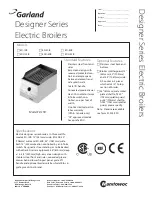
&IGURE
).34!,,!4)/.3%15%.#%
— Separate pipes sidewall
3TEP
Read and follow all instructions in this manual.
$/./4PROCEEDWITH
VENTAIRINSTALLATIONUNTILYOUHAVEREADPAGETHROUGHPAGE
See notices at left and page 21 .
3TEP
Install the boiler in a location that allows proper routing of all vent and air
piping to the selected sidewall location.
3TEP
Make sure the selected sidewall termination location complies with
Figure 28, page 25
. (Multiple boiler sidewall plates must also comply with
Figure 32, page 29 .)
3TEP
Use only the vent materials listed in Figure 27, page 23 . Provide pipe adapters
where required. Vent piping and air piping lengths must not exceed the
values shown in
Figure 26, page 22
.
3TEP
Prepare the sidewall penetrations and secure the sidewall plates as instructed
in this section. See “Prepare wall penetrations” on page 29 .
See notices at left and page 21 .
3TEP
The air piping must terminate in a
DOWNTURNEDELBOW
as shown above.
The vent piping must terminate in an
ELBOWPOINTEDOUTWARDORAWAY
FROMTHEAIRINLET
as shown above. See illustration above.
3TEP
Install vent and air piping between the boiler and the sidewall openings.
Slope horizontal piping downward toward the boiler at least 1/4 inch per
foot. See
page 27
for general guidelines.
See notices at
left and page 21 .
3TEP
Install pipe supports every 5 feet on both the horizontal and vertical runs.
Install a hanger support within 6 inches of any upturn in the piping, or
per vent pipe manufacturer’s instructions.
See notices
at left and page 21 .
3TEP
Attach the vent termination exterior piping: Use either of the confi gurations
shown above, as needed to ensure clearance above grade or snow line.
3TEP
The vent and air pipes may run up as high as 4 feet with no enclosure.
The vent and air pipes must be secured with braces, and all clearances and
lengths must be maintained. Space braces no further than 24 inches apart.
3TEP
External venting greater than 4 feet requires an insulated enclosure around
the vent and air pipes. The vent and air terminations must exit through
the enclosure as shown in the illustration above, maintaining all required
clearances.
53%37%%0%,"/73&/2!,,6%.4!.$!)20)0).'
— DO NOT use short radius elbows for vent or air piping. Boiler
performance could be affected.
Part number 550-100-260/0520
28
ECO
®
Tec
G
AS
-
FIRED
WATER
BOILER
–
80/110/150/199
B
OILER
M
ANUAL
!LLOWABLEVENTAIRPIPEMATERIALS
LENGTHS
Use only the vent materials and kits
listed in Figure 27, page 23 . Provide
pipe adapters if specifi ed.
Locate the termination such that the total air piping
and vent piping from the boiler to the termination
will not exceed the maximum length given in
Figure 26, page 22 .
For polypropylene applications,
See venting and air piping notes on
page 21 .
For AL29-4C vent pipe applications,
See venting and air piping notes on
page 21 .
$ETERMINETERMINATIONLOCATION
1. The air and vent terminations must be installed
as shown in Figure 31 and Figure 34, page 29 .
2. The terminations must comply with clearances
and limitations shown in Figure 28, page 25 .
3. Locate the terminations so they are not likely to
be damaged by foreign objects, such as stones or
balls, or subject to buildup of leaves or sediment.
Do not exceed the maximum lengths
of the outdoor vent piping shown in
Figure 31 . Excessive length exposed to
the outdoor could cause freezing of
condensate in the vent pipe, resulting
in potential boiler shutdown. In
extremely cold climates, install an
insulated chase around the vent
piping, particularly if using longer
lengths. The chase must allow for
inspection of the vent pipe, and
insulation must be protected from
water.
-ULTIPLEVENTAIRTERMINATIONS
1. When terminating multiple boilers, terminate
each vent/air connection as described in this
manual.
All vent pipes and air inlets must
terminate at the same height to avoid
possibility of severe personal injury,
death or substantial property damage.
2. Place wall penetrations to obtain minimum
clearances shown in Figure 32, page 29 for U. S.
installations. For Canadian installations, provide
clearances required by CSA B149.1 or B149.2
Installation Code and a ULC S636 compliant
vent kit.
3. The air inlet of a boiler is part of a direct vent
connection. It is not classifi ed as a forced air
intake with regard to spacing from adjacent
boiler vents.
DIRECT VENT —
Sidewall with separate pipes
















































